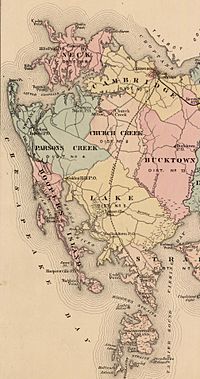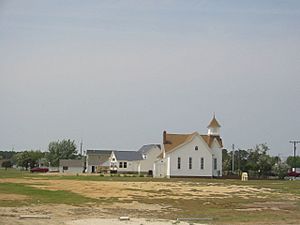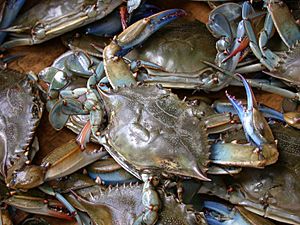Hoopers Island facts for kids
Quick facts for kids
Hoopers Island, Maryland
|
|
|---|---|

1877 map of western Dorchester County showing Hoopers Island
|
|
| Country | United States |
| State | Maryland |
| County | Dorchester |
| Population
(2000)
|
|
| • Total | 441 |
| Time zone | UTC-5 (Eastern (EST)) |
| • Summer (DST) | UTC-4 (EDT) |
| ZIP code |
21634
|
| Area code(s) | 410 |
| GNIS feature ID | 588389 |
Hoopers Island is a group of islands in Dorchester County, United States. It includes Upper Hoopers Island and Middle Hoopers Island. These islands are surrounded by water. The Chesapeake Bay is to the west, and the Honga River is to the east.
This quiet area is home to lots of wildlife. It is also famous for its sport fishing and crabbing industries. Hoopers Island received one of the very first land grants in Dorchester County, Maryland.
Contents
Exploring Hoopers Island's Geography
Hoopers Island is located on the Eastern Shore of Maryland. The islands sit on the east side of the Chesapeake Bay. They are part of Dorchester County.
Hoopers Island is about 20 miles (32 km) long. It is made up of three smaller islands. In many places, the islands are very narrow. You can easily see water on both sides of Maryland Route 335. This road travels right through the islands.
Upper Hoopers Island and Middle Hoopers Island are still above water. Lower Hoopers Island has mostly become marshland over time.
The Rich History of Hoopers Island
The first people to live on Hoopers Island were the Yaocomico tribe. Local stories say that the land was bought from them for five woolen blankets.
Hoopers Island is thought to be the oldest settled area in Dorchester County. The islands are named after Henry Hooper. He was friends with the Calverts. The Calverts were an important family who helped found the state of Maryland.
In the mid-1600s, parts of the islands were measured for Henry Hooper. The first piece of land was called Hooper's Clifts. Later, in 1668, he received another 400 acres (1.6 km2) of land. He got even more land in 1669.
While the Hooper family owned much of the land, other families also had large plots. These included William Chaplin, Richard Bentley, and Philip Shapeley. Some indentured servants, like Thomas Hooten, also received land.
The Hooper Family's Legacy
The Hooper family made Dorchester County their home in 1669. Henry Hooper had a large family. He was married twice and had 14 children.
Henry Hooper was one of the first leaders, called commissioners, of Dorchester County. Many of his children and grandchildren also served in the local government. When he passed away, Hooper left land to his children. These lands had names like Hooper's Chance and Hooper's Fortune.
Island Life: Self-Sufficient and Strong
Because Hoopers Island is surrounded by water, its residents had to be independent. This meant they relied on themselves and each other. The islanders kept strong family and community bonds.
Once families moved to Hoopers Island, they often stayed for many generations. For 300 years, most of the population came from just ten families. The outside world did not quickly change their way of life. Even today, Hoopers Island takes pride in its independence.
Hoopers Island's Changing Environment
Erosion is a big problem for the island. It washes away about 24.19 acres (97,900 m2) of land each year. Storms, floods, and rising water levels also affect the islands.
Since the early 1900s, Lower Hoopers Island has no longer been lived on. It used to be home to a community called Applegarth. This village grew a lot during the oyster boom in the 1880s. But because of erosion, the last resident had to leave in the late 1920s.
Farmers used the island for their animals for a short time after that. However, a hurricane destroyed the bridge to Lower Hoopers Island in 1933. Another part of Hoopers Island, Swan Island, has also almost disappeared.
Amazing Wildlife of Hoopers Island
The marshlands of the islands are full of wild geese and ducks. You can also find many types of birds here. These include little and great blue herons and American oystercatchers.
Other birds you might see are double-crested cormorants and willets. There are also different kinds of gulls and terns. You can spot black ducks, gadwalls, and egrets. Osprey and the boat-tailed grackle also live in and around Hoopers Island.
Daily Life on Hoopers Island
In 2018, about 559 people lived on Hoopers Island. Most residents live in the villages of Honga, Fishing Creek, and Hoopersville.
Honga and Fishing Creek are on Upper Hoopers Island. Hoopersville is the southernmost village, found on Middle Hoopers Island. You can see oyster boats, fishing boats, and crab houses everywhere. These show how important the seafood industry is to island life.
Fun Community Events
The islanders host many great social events. One of the biggest is the William T. Ruark Fishing Tournament. This event has been held every year since 1973.
Other popular events include the Arts and Crafts Auction and Bazaar. The Ronald McGlaughlin Artisans Fair also brings together residents and visitors. These events show the strong community spirit on the island.
A Strong Sense of Community
There is a very strong sense of community among the islanders. People describe them as "strongly independent" and "self-sufficient." They have a great "sense of community" and "fellowship."
Their strong work ethic and family ties have helped them through tough times. For example, in 1954, crabbers went on strike. There were so many crabs that prices dropped, and fishermen weren't making enough money.
Usually, unions organize strikes. But for this strike, there was no union. It was just a group of fishermen who wanted their voices heard. A newspaper article from The Baltimore Sun called the crabbers lazy. The local Volunteer Fire Company wrote a strong letter back. They explained that the fishermen were modern and civilized. They showed that the community could work together without a union to improve their lives.
The Island's Main Industries
Originally, farming was the main industry on the island. Hoopers Island was known for growing tobacco. During the American Revolution, people also grew vegetables and grains.
Today, most people on Hoopers Island work in the fishing industry. Families make a living as crabbers, oyster tongers, and seafood packers. Seasonal workers also help in the processing plants.
Sadly, the fishing industry is facing challenges. Water pollution and other factors are causing the number of crabs to decrease. Governments have made laws to help protect the crabbing industry. For example, in 2008, Maryland and Virginia considered reducing the number of female crabs that could be caught. This worried many watermen, as it could affect their jobs.
In 2009, new rules were put in place for catching female hard crabs. These rules set daily limits and closed periods for harvesting. This helps manage the crab population.
Interesting Places to Visit
Just off the shores of Upper and Middle Hoopers Island is the Hooper's Island Lighthouse. This lighthouse was built in 1906. It is one of only eleven lighthouses of its kind in the United States.
The Phillips Seafood Factory has been open to visitors for over ten years. This factory processes blue crabs. Phillips Seafood is a company that owns restaurants along the East Coast. The company started on the island in 1914. Augustus E. Phillips opened the first seafood processing plant there.
Fun Facts About Hoopers Island
- During the 1700s, pirates were common in the Chesapeake Bay. They would hide in the many small waterways. Then, they would attack boats carrying supplies. One famous pirate, Lord Dunmore, caused so much trouble that in 1780, Henry Hooper IV asked the governor of Maryland for help.
- Near the islands, an area called Meekins Neck is home to the first Catholic church in Dorchester County. St. Mary Star of the Sea was built in 1769.
- From the mid-1880s until 1929, there was a steamboat service to Baltimore. The boat would leave Hoopersville in the late afternoon. It would arrive in Baltimore early the next morning.



